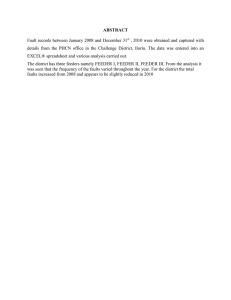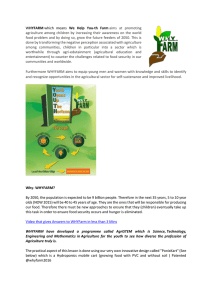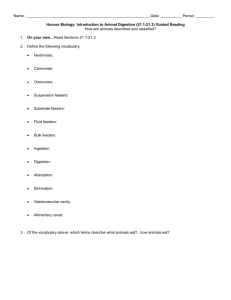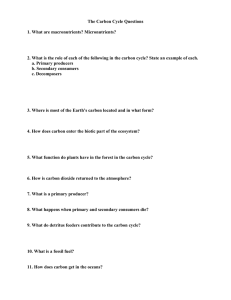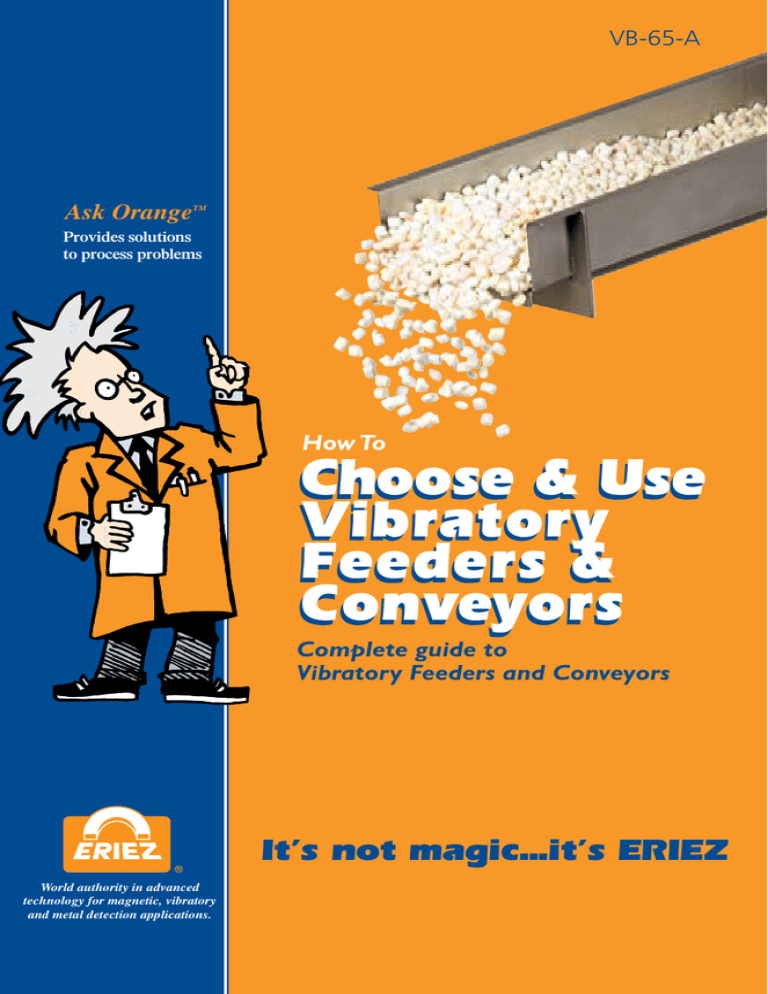
VB-65-A
Ask Orange
TM
Provides solutions
to process problems
How To
Choose & Use
Vibratory
Feeders &
Conveyors
Complete guide to
Vibratory Feeders and Conveyors
It’s not magic...it’s ERIEZ
World authority in advanced
technology for magnetic, vibratory
and metal detection applications.
HOW TO CHOOSE AND USE VIBRATORY FEEDERS & CONVEYORS
Introduction Defining Equipment Terms
Conveying & Feeding
How Vibratory Equipment Works
The Vibratory Movement
Single-Mass Designs & Two-Mass Designs
Equipment Components
Drive Systems
Electromagnetic Drives Mechanical Drives
Spring Systems
Tray or Trough Designs
Material and Process Considerations
Material Considerations
Process Considerations
Vibratory Equipment
Feeders, Electromagnetic
Feeders, Mechanical
Conveyors
Custom Equipment & Applications
3
3
3
4
4
5
6
6
6
7
7
8
9
9
10
11
11
12
12
14
Ask OrangeTM is a collection of process solution
case studies and how-to reference manuals
designed to improve understanding and simplify
specifying sophisticated magnetic, vibratory and
metal detection equipment needed in most process industries. Most of this equipment requires
an understanding of its intended use in order to
determine proper application.
The “Professor” icon has been developed to help customers identify Ask OrangeTM material in printed trade publications, company literature and on
its web site. The Ask Orange concept and related images are a tribute to the
company’s founder, Orange F. Merwin, and his innovative ideas using
magnets to remove metal contamination from various process flows.
HOW TO CHOOSE AND USE VIBRATORY FEEDERS & CONVEYORS
The need to move, convey and feed product exists in virtually all industries. Whether a
sophisticated food processing plant or a simple packaging line, product needs to move
from one area to the next. This book, How to Choose and Use Vibratory Feeders and
Conveyors will focus on selecting vibratory equipment to move raw and unfinished
goods in process applications… meaning, it will not discuss belt conveyors, forklift
trucks, gravity flow storage systems or pick and pack modules moving finished goods.
It is written to help users select the correct vibratory feeder, conveyor or screener for
their particular process or packaging applications. Always read manufacturers’ operating
manuals and safety information prior to equipment operation.
DEFINING EQUIPMENT TERMS
Conveying and Feeding
All of Eriez’ vibratory equipment is designed to simply convey, feed or screen product.
Conveyors and feeders are often used in concert to efficiently move product in and
through a process plant.
In broadest terms, to convey is “to take or carry from one place to another; to transport”.
Typically, conveyors are used to move product from one point to another point in a
process. For example, conveyors might be used to move raw materials from a rail car
to a storage tank, and then again to move that material from the storage tank into the
plant or process. In most process applications, material must be conveyed repeatedly
throughout the plant. In many instances, that product must first be fed onto the conveyor.
Feeders provide more precise “metering” of product.
Feeding by definition, means, “to supply or
maintain a flow of material.” Feeders are placed
throughout a plant to maintain the flow of product
coming into the next stage of the process. In the
example above, the product leaving the storage
tank will likely be fed on to the conveyor going
into the process. A heavy-duty feeder attached to
the bottom of the storage tank will meter-out the
proper amount of material to flow into the process.
Feeders often control the flow of the process and
are typically required to turn off and on frequently,
based on demand.
© 2007 ERIEZ MAGNETICS ALL RIGHTS RESERVED
3
HOW VIBRATORY EQUIPMENT WORKS
The Vibratory Movement
Vibrating, again by definition, means “to move back and forth rapidly.” The equipment
and process solutions described in this guide all use this rapid “back and forth” motion to
move or convey product. On a vibratory feeder, material is “thrown” up and forward so
that it drops to the surface at a point further down the tray. This is the feeder’s amplitude. The number of times per minute that this repeats is the frequency. A third variable
is the angle of deflection… meaning how high the product is thrown as compared to its
horizontal movement.
The diagram (above) illustrates the action of a single particle of material moving along
the tray’s surface. During a vibrating stroke the tray surface travels between its lowest
point “A” to its highest limit “C”. On the upward stroke, the particle is in contact with the
tray from “A” to “B”. At that point the velocity of the particle become greater than the
tray and the particle leaves the surface on a feed flight trajectory from “B” to “D”. The
particle lands forward on the tray at point “D”. This completes one cycle.
With equipment operating on a 60-cycle power supply, this cycle of material flow is
repeated 3600 times per minute. Adjusting or varying the stroke of the tray controls the
feed rate. The number of strokes will remain constant to the power supply. However, the
stroke length can be varied by changing the voltage input to increase or decrease the feed
rate.
Each vibratory feeder or conveyor is designed with a different amplitude, frequency and
angle of deflection in order to move different materials at specific rates. The equipment’s
design is based on many factors including the material being processed, flow rate of the
process, nature of the environment, need to start and stop (cycle) the process, cost to
operate the equipment and likelihood of repairs. All of these considerations are covered in
some detail.
Did you know?
All feeders and conveyors don’t impart the same G forces.
The lower the force, the more gently the product is
handled, resulting in less damage. For instance, Brand A’s
electromagnetic feeder operating at .100 in (2.54 mm)
amplitude at 60Hz imparts 18.4 G’s of energy into the
product. Eriez’ High Deflection Feeders operating at .187 in
(4.75 mm) amplitude, but at a frequency of 30Hz only
imparts 8.6 G’s of force. By using greater amplitude and
reducing the frequency, Eriez is able to accomplish the same
flow rate while causing far less damage to the product!
4
Single-Mass & Two-Mass Designs
Feeders and conveyors transfer their drive’s natural vibration to the tray either through a
single mass or two mass system. The drive unit is contained in the “moving mass” and
creates the vibratory motion. Single-mass units are anchored in position (usually to the
floor) and transfer the drive’s vibration directly to the tray or trough through its springs.
By using the factory’s floor as a reaction base, a single-mass conveyor can be destructive
causing damage and creating vibration in the shop floor.
A Two-mass unit has the “moving mass” connected to the “reaction mass” by springs
which drive the vibration in the tray. Two-mass conveyors and feeders have a natural
frequency of vibration. Eriez’ feeders have a natural frequency range of up to 70 cycles
per second, versus line or operating frequency of 60 cycles making them “subresonant”.
Since the feeder is tuned near operating frequency, it takes advantage of the natural
magnification of vibratory amplitude that occurs when a vibrating system is operating
near its resonant condition. Thus, a relatively small force is amplified to generate the
required vibratory motion.
Did you know?
In order to move the same head load, a single-mass conveyor
would require a 10 horsepower motor, where as a two-mass
system would need only a two horsepower motor.
5
EQUIPMENT COMPONENTS
All vibratory equipment share common components… a drive system to generate the
vibration, a tray or trough to carry the product and springs to give the vibration amplitude creating motion. Every system will require an AC or DC power source and must be
mounted either from above or below in order to produce a consistent force.
Drive Systems
In the mid 1950’s, Eriez parlayed their considerable
knowledge of magnetics and process engineering to develop
a new-patented electromagnetic drive system. This new drive,
named Hi-Vi, offered remarkable advantages over other
systems available in the market. The Hi-Vi drive was the
basis for Eriez’ first feeder product line. Eriez now designs
and builds a complete line of electromagnetic and mechanical
vibratory units.
Electromagnetic Drives
Electromagnetic drive systems operate by either AC or DC power. Both drives use
magnetic circuits to energize the vibratory motion. A spring setup is mounted to a mass
within or on the drive and attached to the unit’s tray. Each of these drives has its
advantages with AC units providing high precision with lower operating costs and the
DC models typically being less expensive.
AC Operated Electromagnetic Drives using “alternating
opposing and attracting magnetic forces” are extremely
accurate, reliable and energy efficient. These units
have no sliding or rotating parts to wear out and
require very little power to operate. Eriez’ patented
AC operated electromagnetic drives incorporate a
permanent magnet whose poles are intermeshed with
those of an electromagnet powered directly by
alternating current. This results in the spring-mounted
moving mass being both attracted and repelled by
the AC electromagnet equally on each half of the AC
cycle. See the diagram A.
Did you know?
Eriez AC electromagnetic drives operate with such high
efficiency they consume up to 65% less energy than typical
DC drives! You can calculate your savings by going to
www.eriez.com.
6
DC Operated Electromagnetic Drives are the most
common type of electromagnetic drive and produce
the same vibratory action as AC operated units.
However, there are some disadvantages. These drives
use a less efficient “attract and release” system where
half of the sine wave is eliminated with a rectifier and
turned into heat, and the DC pulsed power delivery is
much less linear. This means as voltage is increased to
the unit, power is squared. Alternatively, an AC operated drive using the full sine wave delivers power to
the unit proportionately to the voltage increase…
a “smooth” increase in power.
Mechanical Drives
Mechanical vibratory drives come in a wide range of designs. These drives create a back
and forth motion of a tray caused by either a direct mechanical linkage (push rod) or by
a stimulating motion with out-of-balance weights then amplifying that vibration into the
tray through a set of springs. The following are types of mechanical drives:
Brute Force mechanical drives use two special motors with eccentric weights on each
end of a shaft that creates an out-of-balance vibration and motion into the tray. These
are simple designs needing large motors to overcome the head load (weight of material)
resting in the tray.
Eccentric shaft mechanical drives use a standard offthe-shelf motor driving an out-of-balance “eccentric”
shaft. The eccentric shaft creates a small vibration that
is amplified through a spring system. These units are
considered two-mass systems that work to increase
amplitude under the head load.
Direct Drive mechanical drives use a crank arm powered by a rotating motor that is
attached directly to the feeder’s tray. These are less efficient, antiquated designs that
require much larger motors and a lot of maintenance.
Non-Vibratory, Eccentric Shaft mechanical drives use a
set of weights being powered by a motor that is alternately
“in phase” and “out of phase” which creates a slow
motion in one direction and a fast motion in the opposite
direction. This action causes the tray to slide underneath
the material. These units are ideal for fragile materials
that can be damaged from the normal vibratory motion.
Spring Systems
Springs are used to convert the vibration from the drive to tray thus causing product to
move. Springs come in a variety of materials, sizes and configurations. From thin sheets
of fiberglass to dense rubber compounds to thick steel coils… each material is designed
for specific applications. In some applications, a combination of spring materials may be
used.
7
Fiberglass Springs (or boards) are the most popular spring
configuration for light and medium duty applications. Fiberglass springs of varying lengths, widths and thickness are
mounted on the moving mass of the drive and are attached to
the tray or trough. Small electromagnetic feeders, light duty
conveyors and most high precision vibratory equipment use
fiberglass or multiple pieces of fiberglass as their primary
spring action material.
Dense Rubber Springs are typically used on heavy-duty feeders and conveyors to provide
stability and motion control between the drive and the tray. However, rubber springs are
limited to use in environments below 120° F.
Steel Coil Springs are commonly used in heavy duty and high temperature applications.
These coils are effective in ambient temperatures up to 300° F and offer low replacement
cost.
Tray or Trough Designs
In order to function properly, it’s imperative the center of gravity of the tray be mounted
slightly above the driveline of the motor. See diagram A (drive line). The drive line is
generally the centerline of the motor’s casting. Field alterations to the tray or trough will
likely change this balance altering the performance of the feeder.
Selecting the proper tray (feeding) or trough (conveying) depends on the material being
moved, distance traveled and the equipment’s application. Trays and troughs are
fabricated from mild steel and stainless steel. Stainless steel is used in food and
pharmaceutical applications, while mild steel is for general-purpose use. Tray and
troughs can be lined with abrasion resistant steel, stainless, polyethylene, epoxy, rubber
as well as other coatings. The shape, length and width of the tray are almost limitless.
Every configuration of flat, curved, v-channel, tubular designs are available.
C.G. of tray)
Drive line (line passing thru the
C.G. of the drive and tray)
8
MATERIAL AND PROCESS CONSIDERATIONS
There are many factors involved in choosing the proper vibratory feeder, conveyor or
screener. The material being processed is the most important element in selecting
equipment. Many standard models of feeders and conveyors can be fine tuned to
improve the product flow. Selecting the proper equipment for the type of application
can ensure years of trouble free service. Below are some of the key considerations.
Material Considerations
Product Size
One of the most obvious considerations when selecting vibratory equipment is the size of
the material to be processed.
Fine Material
Materials from -50 mesh to -400 mesh do not feed well on traditional Electromagnetic Feeders. They tend to fluidize and flush. The only way to handle them
on vibratory feeders is to use a high deflection electromagnetic (3/16’’ (4.76 mm)
amplitude x 30 Hz) feeder for low capacities or a mechanical (1/4 to 7/16’’
(6.35 to 11.11 mm) amplitude x 20 Hz) feeder for larger capacities.
Midsize Material
Materials ranging from +50 mesh to 2 - 3’’ (50.8 - 76.2 mm) in size feed
very well on traditional Electromagnetic (.045 to .060’’ (1.143 to 1.524 mm)
amplitude x 60 Hz) or Mechanical Feeders. An Electromagnetic Feeder will
offer the most precise control and a Mechanical Feeder or high deflection
Electromagnetic Feeder will offer the greatest capacity.
Coarse Material
Materials in the +2’’ to 12’’ (50.8 -304.8 mm) range are best fed on
mechanical feeders, especially at greater capacities due to the small amount
of surface contact.
Did you know?
Eriez offers a Screen Chart to help determine the proper
mesh screen to size product. This helpful tool can be
downloaded at www.eriez.com.
Product Moisture Content
Moisture may cause severe feeding problems especially on Electromagnetic Feeders,
because moisture increases the surface tension and material tends to build up on the tray
surface. At times, special textured surfaces or liner materials can be used to minimize
this condition.
9
Material Bulk Density
The weight or bulk density of a product effects its feeding characteristics greatly. Light
(less than 10 lbs (4.53 Kg)/cubic feet) materials, especially fine (-50 mesh) do not have as
much mass and feed more slowly than heavier products. High Deflection electromagnetic
or mechanical feeders handle these light weight products effectively.
Did you know?
Eriez’ FeederCap® software helps calculate feeder tray
capacities. Input values from your process and then select
your product’s “Material Bulk Density” from FeederCap’s
comprehensive library and the program automatically
recommends the best feeder for your application.
Available online at www.eriez.com.
Product Flexibility
Rigid or solid products feed better on an Electromagnetic Feeder. Products that are more
flexible can be fed more successfully on high deflection Electromagnetic or Mechanical
Feeders.
Product Durability
Fragile materials are best fed or conveyed on a high deflection vibratory unit. These types
of feeders produce substantial less “G force” than full cycle (60Hz) electromagnetic feeders. Less G force means less product damage.
Feeder Head Loading
Head load is the amount of material weight that is
resting on a feeder. Some feeders are capable of handling
more head load than others handle. If a feeder is being
used under a hopper, it must be capable of starting and
operating at full amplitude with the head load.
Process Considerations
Cycling or Continuous Operation
Different feeders are capable of being cycled (stopped and started) more often. Electromagnetic feeders are ideal for cycling applications and due to their design do not have the
stress put on a belt or clutch when being cycled. These feeders have no belts, bearings or
moving components to wear out.
Type and Length of Service
Is the equipment expected to operate many years without service or is your application
short term? The initial investment for a large Electromagnetic Feeder may be more, but
it is efficient and does not require “normal” maintenance for 10-15 years. This may
make it less expensive over the life of its use.
10
VIBRATORY EQUIPMENT
Feeders, Electromagnetic
Small A & C Model Feeders – These are small
electromagnetic vibratory feeders that operate at
up to .60’’ (15.25 mm) amplitude at line frequency
(either 50-60 Hz). They are commonly used under
hoppers and can offer precise flow of dry granular
products at capacities of up to 500 cubic feet
(14.15 cubic meters)/hour of materials weighing
up to 100 lbs (45.35 Kg)/cubic feet.
High Speed Model Feeders – The HS Feeder is a
variation of the A and C models designed mainly
for packaging and production applications requiring
frequent on/off cycling (up to 100 times/minute).
Being designed mainly for food packaging
applications, they can operate at up to .090’’
(2.28 mm) amplitude at 50-60 cycles and feed up to
600 cubic feet (16.9 cubic meters)/hour of materials
weighing 30-40 lbs (13.6-18.1Kg)/cubic feet.
High Deflection Model Feeders – These unique
Electromagnetic Feeders operate at a higher
(4.76 mm) amplitude and lower frequency
(30 CPS) enabling them to handle hard-to-feed
materials such as fine powders and flexible leafy
products. The HD series can handle up to 19.82
cubic meters/hour of light products such as cereal
weighing 4.53-6.8 Kg/cubic feet.
B Feeders – Eriez B Feeders are heavy duty
Electromagnetic Feeders designed for the glass,
steel, chemical, fastener, coal, and aggregate
markets where high capacity is required with the
best linearity. B Feeders are virtually maintenance
free. They can be provided with abrasion resistant
replaceable liners and with capacities of 400-1700
cubic feet (11.32 - 48.13 cubic meters)/hour.
11
Feeders, Mechanical
HV Feeders – is a unique low profile two-mass rubber spring design using many
standard off-the-shelf components. It is ideal for use in tunnels or in areas where
headroom is a problem. HV Feeders have capacities of 2,000-40,000 cubic feet
(56.63 to 1132.67 cubic meters)/hour of aggregates, glass, steel, and coal.
Brute Force Feeders – are single mass Mechanical Feeders powered by twin rotary
motors. They are a very simple design and handle shock loading well, but lose power
under heavy head loading. These units are very easy to repair, because you simply
change the weighted motor.
Conveyors
VMC Conveyors – is an Electromagnetic Conveyor that is virtually maintenance free
(no belts or bearings) and has excellent linearity from 20% to 100%. Since it is
electromagnetic, it is very good for cycling applications.
12
SM Conveyors - Single mass units are Eriez’ least expensive mechanical conveyors,
because they use the floor or base as their reaction mass. This allows for a low profile
and efficient system to convey materials and parts. These efficient single mass
conveyors move light loads of bulk materials at flow rates up to 18 tph (16mtph).
TM Conveyors – are two-mass Mechanical Conveyors designed for medium duty
applications such as food and pharmaceutical. They use off-the-shelf motors,
standard bearings and fiberglass springs.
HV Conveyors – is a heavy duty two-mass Mechanical Conveyor designed for coal,
glass, and aggregate type applications. It can be supplied with replaceable AR liners.
It uses a unique rubber spring that can be adjusted for the optimum drive angle.
Horizontal Motion Conveyors – The E-Z SlideTM Horizontal Motion Conveyor is ideal
where gentle handling of self-cleaning is required such as in snack foods or processing
of friable products. The unique drive causes the tray to move forward slowly carrying
the product, then reverse rapidly, causing the tray to slide back quickly.
13
.CUSTOM EQUIPMENT & APPLICATIONS
Eriez operates the largest Test and Research facility of its kind for developing custom
equipment to meet the most demanding applications. Contact a product manager to
design the perfect vibratory solution for your specific needs. FOR MORE INFORMATION on vibratory feeders, conveyors or any of the many
other vibratory components and systems available for automation, material
movement, separation, purification, beneficaition, reclamation and pollution
control, write or call
ERIEZ MAGNETICS WORLD HEADQUARTERS
2200 Asbury Road, P.O. Box 10608, Erie, Pennsylvania 16514, U.S.A.
800/345-4946 or 814/835-6000
Plate Magnets
Grate Magnets
Ferrous Traps
Magnetic Humps
Suspended Magnets
Magnetic Pulleys
Magnetic Sweepers
Dry Magnetic Drums
Wet Magnetic Drums
High Intensity Separators
Electrostatic Separators
Superconducting HGMS
Rare Earth Magnetic Roll Separators
Magnetic Flocculators
Demagnetizing Coils
Metal Detectors
NOTES:
14
Eddy Current Separators
Magnetic Rails
Magnetic Rolls
Sheet Fanners
Lifting Magnets
Holding Magnets
Coolant Cleaners
Magnetic Conveyors
Vibrating Conveyors
Mechanical Conveyors
Vibratory Feeders
Volumatic Feeders
Bin Vibrators
Precipitator Vibrators
Screen Separators
For
For solutions
solutions to
to
your
your process
process problems
problems
contact
your
contact your nearest
nearest
Eriez
Eriez representative
representative
and
and just:
just: Ask
Ask Orange.
Orange.
Contact eriez
With manufacturing plants on five continents and a global network of factorytrained representatives, getting professional assistance is just a call away.
Country Code:
Telephone:
E-mail:
Australia ...................61........3-9305-4099.................. eriezaus@eriez.com.au
Canada .......................01........905-795-0444.................. eriezcanada@eriez.ca
China ............................86........21-5046-2123..................... eriez@eriez.com.cn
Europe .........................44........29-208-68501.............eriez@eriezeurope.co.uk
India .............................91........80-845-5381..............................emil@emil.co.in
Japan ............................81........473-546381.......................thomma@eriez.co.jp
Mexico .........................52........5-565-3855................. operaciones@avante.net
South Africa .............27........11-444-9160................... eriezmag@iafrica.com
United States ............01.........814-835-6000...........................eriez@eriez.com
©2007 ERIEZ MAGNETICS ALL RIGHTS RESERVED
15
World authority in advanced technology for magnetic,
vibratory and inspection applications
Eriez manufactures magnetic lift and separation, metal detection, materials
feeding, screening, conveying and controlling equipment for application in
the process, metal working, packaging, recycling, mining, aggregate and
textile industries among others. Eriez manufactures and markets these
products through nine international facilities located on five continents...
Australia, Brazil, Canada, China, England, India, Japan, Mexico, South Africa,
as well as the United States.
Some safety warning labels or guarding may have been removed before
photographing this equipment.
0707-5M-SBC-MC

